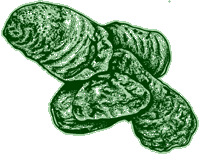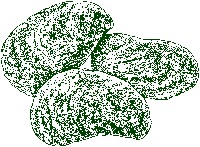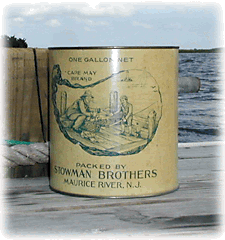Subject Areas
Language Arts, Art, Science, Social Studies
Duration
One or two class periods
Setting
Indoors/Classroom
Skills
Creative writing, inferring, grouping and categorizing, developing, presenting
Charting the Course
Many of the people from Down Jersey have a connection to the oyster either past or present. The abundance of the oyster and the favorable conditions found within the Delaware Bay have made it the single most important individual species that shaped the region’s unique history. Many other species of  wildlife and resources were (and are) harvested and had tremendous impacts and consequences as well. None is as significant as the Eastern Oyster which touches every main theme area presented in this packet and in the film Down Jersey. wildlife and resources were (and are) harvested and had tremendous impacts and consequences as well. None is as significant as the Eastern Oyster which touches every main theme area presented in this packet and in the film Down Jersey.
Vocabulary
Spat, staple, prosperity, substrate, seed beds, harvest, dredge
Correlation to NJ Core Curriculum Content Standards
Language Art: 3.3 (1,2,4,9), 3.5 (1,2,3,6,7,11,13,14,15)
Art: 1.1 (2), 1.3 (1,2)
Social Studies: 6.3 (1), 6.4 (1), 6.5 (4,5), 6.6 (2,3,4,5), 6.9 (1,2,3)
Science: 5.6 (2,4,5), 5.7 (1,4), 5.12 (1,2,3,4,5) |
Objectives
- Identify and describe a number of biological, cultural and historical facts about the oyster and oyster harvesting.
- Illustrate a particular feature, event or issue surrounding the oyster industry as it relates to the Delaware Bay Shore of Southern New Jersey.
Materials
Photocopies of the interesting facts included — make copies of the fact pages, cut into strips, and have ready to distribute (Suggestion: You may want to laminate the facts for durability)
A variety of art materials; examples of comic strips or advertisements and/or fliers.
Making Connections
The importance of the oyster industry to the historical development, prosperity, and way of life for the Down Jersey area is profound. The mere fact that oysters lived in the Delaware Bay and people wanted (and needed) to harvest and consume them is the main reason for the development of entire towns. Entire towns grew around the oyster, the common denominator among Bivalve, Shellpile, Maurice River, and Port Norris. The film Down Jersey captures some of the impact of the interconnections that formed among the people, the resource, and the region. Realizing the importance and value of a balance among the uses of natural resources and our dependence on them is a lesson to be learned for sustainability. Perhaps the story and history of the oystering industry can provide us insight into the intricacies and fragility of the environment.
 Background Background
See other oyster activities for background information included in this packet. Historic Themes and Resources book 46-51 and Oyster Fact Sheet.
Procedure
Warm Up
Bring in some oysters or oyster shells to show the class.
If possible:
Demonstrate how to “shuck” an oyster and explain why it requires a lot of skill and practice to be a worthy employee of a “shucking house” where time was money. (Perhaps a parent or grandparent or an oysterman could be invited in to class to assist.)
Bring in a can of oysters and allow students to taste them. Ask students why they think oysters were so popular? Ask students to describe what they know about oysters. Are any family members associated with the oyster industry? Who? When? How?
Make a recipe that uses oysters — oyster stew, oysters Rockefeller, others from students’ families, etc.
The Activity
- Share some of the background information with the class. Read some of the interesting oyster facts. Has anyone ever eaten oysters? Does anybody have a family member who works in the oyster industry, or used to?
- Tell the students that they are going to be creating comic strips or fliers that illustrate some very interesting things about oysters.
- Distribute the interesting facts to the students (each student gets a different fact.) As an additional activity, have students research and make their own fact cards.
- Each student should read his or her fact to the class in a “round-robin” format. As a class, partners should be chosen to form a group activity with the statements that seem to fit together or are related. This may require the teacher or designated student to use the blackboard to record the students with a particular topic. Examples of categories for this grouping could be: Oyster Biology, Oyster Industry, People and Oysters, Oyster Problems, etc.
There really is no “right” way to divide the cards to form the groups. It may be an interesting adaptation to allow it to occur randomly.
- Once the groups are formed, they are assigned to collectively design and produce an informational poster, a comic strip, a flier or brochure, a story, a poem, etc. Let their imaginations dictate their project choice, or at the teacher’s discretion.
Wrap Up
Have each team present its project to the class and explain, describe, and demonstrate what was learned about the oyster.
 Action Action
Share the projects produced with the school and community.
Assessment
Evaluate the completed projects for evidence of the facts to determine that objectives have been met.
Extensions
Have students design an original oyster can label.
Choose an oyster topic and research it thoroughly. Prepare a report.
Invite someone into class to talk about the oyster industry. Prepare a series of questions for them ahead of time if possible.
See related activity…Operation Oyster — Significant Events in the History of Oystering
Visit the…
Bayshore Discovery Project’s Museum to see oystering artifacts and tools of the industry.
Better yet, go oystering on the AJ Meerwald!
ShellPile Restaurant has a large collection of oyster cans.
Rutgers University, Haskins Shellfish Research Laboratory, 6959 Miller Avenue, Port Norris
Please download the PDF for the complete Lesson Plan.
| Resources
Living Resources of the Delaware Estuary. Produced by The Delaware Estuary Program. Ford, S.E., Haskin, H.H., and Kraeuter, J.N. 1995 Eastern Oyster. Pages 105-111 in L.E. Dove and R.M. Nyman, eds.
The Delaware Bay Oyster and the MSX Problem, Christopher Dyckman, Editor, College of Marine Studies, University of Delaware, Newark Delaware.
Beneath the Shell, NJDEP, Office of Environmental Planning. An activity guide that addresses the shellfish of New Jersey and the impacts of environmental disturbance, especially nonpoint source pollution.
The Awesome Oyster, by Penny Parekian, Mystic Seaport Museum, Inc. Greenmanville Avenue, Mystic, Connecticut 06355
Oyster Cans, Jim and Vivian Karsnitz, Shiffer Publishing Ltd., 77 Lower Valley Road, Atglen, PA 19310. Details the history of oyster canning with numerous photographic examples included. |
|


 wildlife and resources were (and are) harvested and had tremendous impacts and consequences as well. None is as significant as the Eastern Oyster which touches every main theme area presented in this packet and in the film Down Jersey.
wildlife and resources were (and are) harvested and had tremendous impacts and consequences as well. None is as significant as the Eastern Oyster which touches every main theme area presented in this packet and in the film Down Jersey. Background
Background  Action
Action